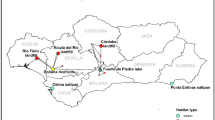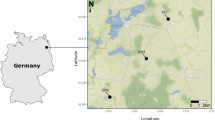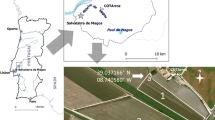Abstract
Aquatic invertebrates can be geographically dispersed by abiotic vectors (wind, rain and water flow) or organisms (mainly by insects, fishes and waterbirds). However, there is a lack of information on the dispersal by waterbirds of cladocerans and especially rotifers, and on the hatching success of the dispersed propagules. Here, we quantify the dispersal of cladocerans and rotifers by waterbirds through analysis of their faecal droppings collected in a wetland formed by two natural lakes located in Doñana National Park (Spain). We also study the influence of different photoperiod and temperature conditions on the hatching success of the dispersal propagules. Diapausing propagules of 22 species of rotifers or cladocerans were identified in waterbird faecal droppings, with a mean number of 0.9 diapausing propagules per dropping. The hatching success rate, which was not influenced by photoperiod or temperature, was low (~ 12.5%). Nevertheless, the role of rotifer dispersal by waterbirds appears to have been underestimated in the past. In this study area, the dispersal of rotifers by waterbirds may be at least as relevant as their dispersal by air currents. Further studies are needed to evaluate the relative importance of dispersal mechanisms (mainly air currents and animal vectors) in different geographical areas.




Similar content being viewed by others
References
Battauz, Y. S., S. B. J. de Paggi & J. C. Paggi, 2015. Endozoochory by an ilyophagous fish in the Parana River floodplain: a window for zooplankton dispersal. Hydrobiologia 755: 161–171.
Bohonak, A. & D. G. Jenkins, 2003. Ecological and evolutionary significance of dispersal by freshwater aquatic invertebrates. Ecology Letters 6: 783–796.
Bolker, B., H. Skaug, A. Magnusson & A. Nielsen, 2012. Getting started with the glmmADMB package. http://glmmadmb.r-forge.r-project.org/glmmADMB.pdf
Bolker, B. M., 2015. Linear and generalized linear mixed models. In Fox, G. A., S. Negrete-Yankelevich & V. J. Sosa (eds), Ecological Statistics: Contemporary Theory and Application. Oxford University Press, New York: 309–334.
Bolker, B. M., M. E. Brooks, C. J. Clark, S. W. Geange, J. R. Poulsen, M. H. H. Stevens & J. S. S. White, 2009. Generalized linear mixed models: a practical guide for ecology and evolution. Trends in Ecology & Evolution 24: 127–135.
Brendonck, L., T. Pinceel & R. Ortells, 2017. Dormancy and dispersal as mediators of zooplankton population and community dynamics along a hydrological disturbance gradient in inland temporary pools. Hydrobiologia 796: 201–222.
Brochet, A. L., M. Guillemain, H. Fritz, M. Gauthier-Clerc & A. J. Green, 2009. The role of migratory ducks in the long-distance dispersal of native plants and the spread of exotic plants in Europe. Ecography 32: 919–928.
Burnham, K. P. & D. R. Anderson, 2002. Model Selection and Multimodel Inference, 2nd ed. Springer-Verlag, New York.
Cáceres, C. E. & D. A. Soluk, 2002. Blowing in the wind: a field test of overland dispersal and colonization by aquatic invertebrates. Oecologia 131: 402–408.
Campillo, S., M. Serra, M. J. Carmona & A. Gómez, 2011. Widespread secondary contact and new glacial refugia in the halophilic rotifer Brachionus plicatilis in the Iberian Peninsula. PloS One 6: e20986.
Charalambidou, I. & L. Santamaría, 2002. Waterbirds as endozoochorous dispersers of aquatic organisms: a review of experimental evidence. Acta Oecologica 23: 165–176.
Cohen, G. M. & J. B. Shurin, 2003. Scale-dependence and mechanisms of dispersal in freshwater zooplankton. Oikos 103: 603–617.
Conde-Porcuna, J. M., E. Ramos-Rodríguez & C. Pérez-Martínez, 2014. In situ production of empty ephippia and resting eggs by an obligate parthenogenetic Daphnia population. Journal of Plankton Research 36: 157–169.
Conde-Porcuna, J. M., C. Pérez-Martínez & E. Moreno, 2018. Variations in the hatching response of rotifers to salinity and waterbird ingestion. Journal of Plankton Research 40: 326–341.
De Meester, L., A. Gómez, B. Okamura & K. Schwenk, 2002. The monopolization hypothesis and the dispersal-gene flow paradox in aquatic organisms. Acta Oecologica 23: 121–135.
Dupuis, A. P. & B. J. Hann, 2009. Climate change, diapause termination and zooplankton population dynamics: an experimental and modeling approach. Freshwater Biology 54: 221–235.
Equipo de Seguimiento de Doñana; ICTS-Reserva Biológica de Doñana (EBD-CSIC). Memoria del año hidrometeorológico 2008–2009. 2009. Programa de Seguimiento de Procesos y Recursos Naturales en el Espacio Natural Doñana; Dirección General de Espacios Naturales y Participación Ciudadana. Junta de Andalucía—Estación Biológica de Doñana (CSIC): Sevilla, Spain.
Equipo de Seguimiento de Doñana; ICTS-Reserva Biológica de Doñana (EBD-CSIC). Memoria del año hidrometeorológico 2009–2010. 2010. Programa de Seguimiento de Procesos y Recursos Naturales en el Espacio Natural Doñana; Dirección General de Espacios Naturales y Participación Ciudadana. Junta de Andalucía—Estación Biológica de Doñana (CSIC): Sevilla, Spain.
Espinar, J. L. & L. Serrano, 2009. A quantitative geomorphological approach to the classification of temporary wetlands in the Doñana National Park (SW Spain). Aquatic Ecology 43: 323–334.
Espinar, J. L., L. V. García, J. Figuerola, A. J. Green & L. Clemente, 2004. Helophyte germination in a Mediterranean salt marsh: Gut-passage by ducks changes seed response to salinity. Journal of Vegetation Science 15: 315–322.
Evans, M. E. K. & J. J. Dennehy, 2005. Germ banking: bet-hedging and variable release from egg and seed dormancy. The Quarterly Review of Biology 80: 431–451.
Figuerola, J. & A. J. Green, 2002. Dispersal of aquatic organisms by waterbirds: a review of past research and priorities for future studies. Freshwater Biology 47: 483–494.
Figuerola, J., A. J. Green & L. Santamaría, 2002. Comparative dispersal effectiveness of wigeongrass seeds by waterfowl wintering in south-west Spain: quantitative and qualitative aspects. Journal of Ecology 90: 989–1001.
Figuerola, J., A. J. Green & L. Santamaría, 2003. Passive internal transport of aquatic organisms by waterfowl in Donana, south-west Spain. Global Ecology and Biogeography 12: 427–436.
Fisher, N. I., 1995. Statistical analysis of circular data. Cambridge University Press, Cambridge.
Fournier, D. A., H. J. Skaug, J. Ancheta, J. Ianelli, A. Magnusson, M. Maunder, A. Nielsen & J. Sibert, 2012. AD Model Builder: using automatic differentiation for statistical inference of highly parameterized complex nonlinear models. Optimization Methods & Software 27: 233–249.
Frisch, D., A. J. Green & J. Figuerola, 2007. High dispersal capacity of a broad spectrum of aquatic invertebrates via waterbirds. Aquatic Sciences 69: 568–574.
García-Roger, E. M., M. J. Carmona & M. Serra, 2005. Deterioration patterns in diapausing egg banks of Brachionus (Müller, 1786) rotifer species. Journal of Experimental Marine Biology and Ecology 314: 149–161.
García-Roger, E. M., M. J. Carmona & M. Serra, 2006. Hatching and viability of rotifer diapausing eggs collected from pond sediments. Freshwater Biology 51: 1351–1358.
García-Roger, E. M., M. Serra & M. J. Carmona, 2014. Bet-hedging in diapausing egg hatching of temporary rotifer populations - A review of models and new insights. International Review of Hydrobiology 99: 96–106.
Green, A. J. & J. Figuerola, 2005. Recent advances in the study of long distance dispersal of aquatic invertebrates via birds. Diversity and Distributions 11: 149–156.
Green, A. J., J. Figuerola & M. I. Sánchez, 2002. Implications of waterbird ecology for the dispersal of aquatic organisms. Acta Oecologica 23: 177–189.
Green, A. J., K. M. Jenkins, D. Bell, P. J. Morris & R. T. Kingsford, 2008. The potential role of waterbirds in dispersing invertebrates and plants in arid Australia. Freshwater Biology 53: 380–392.
Green, A. J., D. Frisch, T. C. Michot, L. K. Allain & W. C. Barrow, 2013. Endozoochory of seeds and invertebrates by migratory waterbirds in Oklahoma, USA. Limnetica 32: 39–46.
Green, A. J., J. Bustamante, G. F. E. Janss, R. Fernández-Zamudio & C. Díaz-Paniagua, 2016. Doñana wetlands (Spain). In Finlayson, C. M., G. R. Milton, R. C. Prentice & N. C. Davidson (eds), The Wetland Book: II: Distribution, Description and Conservation. Springer, Dordrecht: 1–14.
Gyllström, M. & L. Hansson, 2004. Dormancy in freshwater zooplankton: induction, termination and the importance of benthic-pelagic coupling. Aquatic Sciences 66: 274–295.
Havel, J. E. & J. B. Shurin, 2004. Mechanisms, effects, and scales of dispersal in freshwater zooplankton. Limnology and Oceanography 49: 1229–1238.
Holland, T. A. & D. G. Jenkins, 1998. Comparison of processes regulating zooplankton assemblages in new freshwater ponds. Hidrobiologia 387(388): 207–214.
Jammalamadaka, S. R. & U. J. Lund, 2006. The effect of wind direction on ozone levels: a case study. Environmental and Ecological Statistics 13: 287–298.
Jenkins, D. G., 1995. Dispersal-limited zooplankton distribution and community composition in new ponds. Hydrobiologia 313(314): 15–20.
Jenkins, D. G. & A. L. Buikema Jr., 1998. Do similar communities develop in similar sites? A test with zooplankton structure and function. Ecological Monographs 63: 421–443.
Jenkins, D. G. & M. O. Underwood, 1998. Zooplankton may not disperse readily in wind, rain or waterfowl. Hydrobiologia 387(388): 15.
Johnson, R. A. & T. E. Wehrly, 1978. Some angular-linear distributions and related regression models. Journal of the American Statistical Association 73: 602–606.
Koste, W., 1978. Rotatoria Die Radertiere Mitteleuropas bergriindet von Max Voigt-Monogononta. 2. Auflage neubearbeitet von Walter Koste. Gebrlider Borntraeger, Berlin.
Lindén, A. & S. Mäntyniemi, 2011. Using the negative binomial distribution to model overdispersion in ecological count data. Ecology 92: 1414–1421.
Lopes, P. M., R. Bozelli, L. M. Bini, J. M. Santangelo & S. A. J. Declerck, 2016. Contributions of airborne dispersal and dormant propagule recruitment to the assembly of rotifer and crustacean zooplankton communities in temporary ponds. Freshwater Biology 61: 658–669.
López-Archilla, A. I., M. Coleto, C. Montes, I. Penin & M. C. Guerrero, 2012. Temporal variation of phytoplankton in two neighbouring Mediterranean shallow lakes in Doñana National Park (Spain). Limnetica 31: 289–304.
Louette, G. & L. De Meester, 2005. High dispersal capacity of cladoceran zooplankton in newly founded communities. Ecology 86: 353–359.
Lovas-Kiss, Á., M. I. Sánchez, A. V. Molnár, L. Valls, X. Armengol, F. Mesquita-Joanes & A. J. Green, 2018. Crayfish invasion facilitates dispersal of plants and invertebrates by gulls. Freshwater Biology 63: 392–404.
Lukaszewski, Y., S. E. Arnott & T. M. Frost, 1999. Regional versus local processes in determining zooplankton community composition of Little Rock Lake, Wisconsin, USA. Journal of Plankton Research 21: 991–1003.
Marcus, N. H., 1990. Calanoid copepod, cladoceran, and rotifer eggs in sea bottom sediments of northern Californian coastal waters: identification, occurrence and hatching. Marine Biology 105: 413–418.
Mardia, K. V., 1976. Linear-circular correlation coefficients and rhythmometry. Biometrika 63: 403–405.
Mardia, K. V. & P. E. Jupp, 2000. Directional Statistics. Wiley, New York.
Marion, L., P. Clergeau, L. Brient & G. Bertru, 1994. The importance of avian-contributed nitrogen (N) and phosphorus (P) to Lake Grand-Lieu, France. In Kerekes, J. J. (ed.), Aquatic Birds in the Trophic Web of Lakes. Developments in Hydrobiology. Springer, Dordrecht: 133–147.
Martin, T. G., B. A. Wintle, J. R. Rhodes, P. M. Kuhnert, S. A. Field, S. J. Low-Choy, A. J. Tyre & H. P. Possingham, 2005. Zero tolerance ecology: improving ecological inference by modelling the source of zero observations. Ecology Letters 8: 1235–1246.
May, L., 1986. Rotifer sampling-a complete species list from one visit. Hydrobiologia 134: 117–120.
Michels, E., K. Cottenie, L. Neys & L. De Meester, 2001. Zooplankton on the move: first results on the quantification of dispersal of zooplankton in a set of interconnected ponds. Hydrobiologia 442: 117–126.
Moreno, E., C. Pérez-Martínez & J. M. Conde-Porcuna, 2016. Dispersal of zooplankton dormant propagules by wind and rain in two aquatic systems. Limnetica 35: 323–336.
Moreno, E., J. M. Conde-Porcuna & A. Gómez, 2017. Barcoding rotifer biodiversity in Mediterranean ponds using diapausing egg banks. Ecology and Evolution 7: 4855–4867. https://doi.org/10.1002/ece3.2986.
Muñoz, J., A. Gómez, J. Figuerola, F. Amat, C. Rico & A. J. Green, 2014. Colonization and dispersal patterns of the invasive American brine shrimp Artemia franciscana (Branchiopoda: Anostraca) in the Mediterranean region. Hydrobiologia 726: 25–41.
Onbé, T., 1978. Sugar flotation method for the sorting the eggs of marine cladocerans and copepods from sea-bottom sediment. Bulletin of the Japanese Society of Scientific Fisheries 44: 1411.
Pérez-Martínez, C., L. Jiménez, E. Moreno & J. M. Conde-Porcuna, 2013. Emergence pattern and hatching cues of Daphnia pulicaria (Crustacea, Cladocera) in an alpine lake. Hydrobiologia 707: 47–57.
Pinceel, T., B. Vanschoenwinkel, W. Hawinkel, K. Tuytens & L. Brendonck, 2017. Aridity promotes bet hedging via delayed hatching: a case study with two temporary pond crustaceans along a latitudinal gradient. Oecologia 184: 161–170.
Pinheiro, J. C. & D. M. Bates, 2000. Mixed-Effects Models in S and SPLUS. Springer-Verlag, New York.
Proctor, V. W. & C. R. Malone, 1965. Further evidence of the passive dispersal of small aquatic organisms via the intestinal tract of birds. Ecology 46: 728–729.
Ricklefs, R. E., 1987. Community diversity: relative roles of local and regional processes. Science 235: 167–171.
Rogers, D. C., 2014. Larger hatching fractions in avian dispersed anostracan eggs (Branchiopoda). Journal of Crustacean Biology 34: 135–143.
Sánchez, M. I., F. Hortas, J. Figuerola & A. J. Green, 2012. Comparing the potential for dispersal via waterbirds of a native and an invasive brine shrimp. Freshwater Biology 57: 1896–1903.
Schielzeth, H. & S. Nakagawa, 2013. Nested by design: model fitting and interpretation in a mixed model era. Methods in Ecology and Evolution 4: 14–24.
Serrano, L. & M. Zunzunegui, 2008. The relevance of preserving temporary ponds during drought: hydrological and vegetation changes over a 16-year period in the Doñana National Park (south-west Spain). Aquatic Conservation-Marine and Freshwater Ecosystems 18: 261–279.
Serrano, L., M. Reina, G. Martín, I. Reyes, A. Arechederra, D. León & J. Toja, 2006. The aquatic systems of Doñana (SW Spain): watersheds and frontiers. Limnetica 25: 11–32.
Shurin, J. B., J. E. Havel, M. A. Leibold & B. Pinel-Alloul, 2000. Local and regional zooplankton species richness: a scale-independent test for saturation. Ecology 81: 3062–3073.
Sirianni, K. M., 2017. Differential wind dispersal of cladoceran ephippia in a rock pool metacommunity. Aquatic Ecology 51: 203–218.
Skaug H, D. Fournier, A. Nielsen, A. Magnusson & B. Bolker, 2016. Generalized Linear Mixed Models using AD Model Builder. R package version 0.8.3.3
Ślusarczyk, M. & S. Flis, 2019. Light quantity, not photoperiod terminates diapause in the crustacean Daphnia. Limnology and Oceanography 64: 124–130.
Soons, M. B., A. L. Brochet, E. Kleyheeg & A. J. Green, 2016. Seed dispersal by dabbling ducks: an overlooked dispersal pathway for a broad spectrum of plant species. Journal of Ecology 104: 443–455.
Stross, R. G., 1966. Light and temperature requirements for diapause development and release in Daphnia. Ecology 47: 368–374.
van Leeuwen, C. H. A., A. Lovas-Kiss, M. Ovegard & A. J. Green, 2017. Great cormorants reveal overlooked secondary dispersal of plants and invertebrates by piscivorous waterbirds. Biology Letters 13: 20170406.
Valls, L., A. Castillo-Escriva, L. Barrera, E. Gómez, J. A. Gil-Delgado, F. Mesquita-Joanes & X. Armengol, 2017. Differential endozoochory of aquatic invertebrates by two duck species in shallow lakes. Acta Oecologica 80: 39–46.
Vandekerkhove, J., B. Niessen, S. Declerck, E. Jeppesen, J. M. Conde-Porcuna, L. Brendonck & L. De Meester, 2004. Hatching rate and success of isolated versus non-isolated zooplankton eggs. Hydrobiologia 526: 235–241.
Vandekerkhove, J., S. Declerck, L. Brendonck, J. M. Conde-Porcuna, E. Jeppesen & L. De Meester, 2005. Hatching of cladoceran resting eggs: temperature and photoperiod. Freshwater Biology 50: 96–104.
Vanschoenwinkel, B., C. De Vries, M. Seaman & L. Brendonck, 2007. The role of metacommunity processes in shaping invertebrate rock pool communities along a dispersal gradient. Oikos 116: 1255–1266.
Vanschoenwinkel, B., S. Gielen, M. Seaman & L. Brendonck, 2008a. Any way the wind blows - frequent wind dispersal drives species sorting in ephemeral aquatic communities. Oikos 117: 125–134.
Vanschoenwinkel, B., A. Waterkeyn, T. Vandecaetsbeek, O. Pineau, P. Grillas & L. Brendonck, 2008b. Dispersal of freshwater invertebrates by large terrestrial mammals: a case study with wild boar (Sus scrofa) in Mediterranean wetlands. Freshwater Biology 53: 2264–2273.
Welsh, A. H., R. B. Cunningham & R. Chambers, 2000. Methodology for estimating the abundance of rare animals: seabird nesting on North East Herald Cay. Biometrics 56: 22–30.
Acknowledgements
Financial support was provided by the Project CGL2007-65784/BOS, which was funded by the Inter-ministerial Commission of Science and Technology of Spain. E. Moreno was supported by a FPI fellowship from the Spanish Ministry of Education and Science. The authors thank David G. Jenkins and two anonymous reviewer for substantially improving the manuscript and are grateful to the Doñana Biological Station for its collaboration. The authors are also grateful to Richard Davies for linguistic improvements.
Author information
Authors and Affiliations
Corresponding author
Ethics declarations
Conflict of interest
The authors declare that they have no conflict of interest.
Additional information
Handling editor: Andrew Dzialowski
Publisher's Note
Springer Nature remains neutral with regard to jurisdictional claims in published maps and institutional affiliations.
Rights and permissions
About this article
Cite this article
Moreno, E., Pérez-Martínez, C. & Conde-Porcuna, J.M. Dispersal of rotifers and cladocerans by waterbirds: seasonal changes and hatching success. Hydrobiologia 834, 145–162 (2019). https://doi.org/10.1007/s10750-019-3919-6
Received:
Revised:
Accepted:
Published:
Issue Date:
DOI: https://doi.org/10.1007/s10750-019-3919-6




